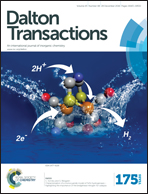Tuning of chain chirality by interchain stacking forces and the structure–property relationship in coordination systems constructed by meridional FeIII cyanide and MnIII Schiff bases†
Abstract
We synthesized six Fe(III)–Mn(III) bimetallic compounds by self-assembling the newly developed mer-Fe cyanide PPh4[Fe(Clqpa)(CN)3]·H2O (1) and PPh4[Fe(Brqpa)(CN)3]·H2O (2) with Mn Schiff base Mn(5-Xsalen)+ cations. These compounds include [Fe(Xqpa)(CN)3][Mn(5-Ysalen)]·pMeOH·qH2O [qpaH2 = N-(quinolin-8-yl)picolinamide; salen = N,N′-ethylenebis(salicylideneiminato) dianion; X = Cl, Y = H (3); X = Cl, Y = Br (4); X = Br, Y = H (5); X = Br, Y = F (6); X = Br, Y = Cl (7); X = Br, Y = Br (8)]. When precursor 1 was used, compounds 3 and 4 were isolated to give a dinuclear entity and a linear chain structure, respectively. The reaction of precursor 2 with the Schiff bases afforded four linear Fe(III)–Mn(III) chain complexes. Chain chirality with P- and M-helicity emerges in 4, 7, and 8, while 5 exhibits chain helicity opposite to the previous chain complexes and 6 presents no chain helicity. Such a structural feature is heavily dependent on the interchain π–π contacts and the Fe precursor bridging unit. Chiral induction from a local ethylenediamine link of Y-salen is propagated over the chain via noncovalent π–π interactions. All the bimetallic compounds show antiferromagnetic interactions transmitted by the cyanide linkage. A field-induced metamagnetic transition is involved in 4, 7, and 8, while a field-induced two-step transition is evident in 6. From a magnetostructural viewpoint, the coupling constant is primarily governed by the Mn–Nax–Cax angle (ax = axial) in the bimetallic chain complexes composed of mer-Fe(III) tricyanides, although the torsion angle plays a role.


 Please wait while we load your content...
Please wait while we load your content...